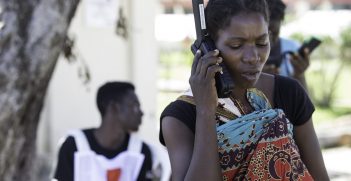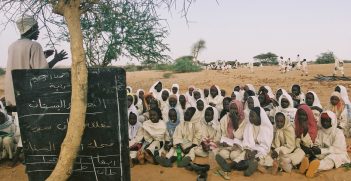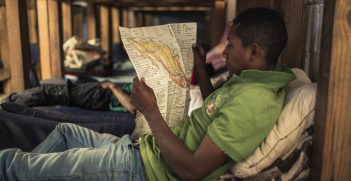Forgotten Conflicts 2021: In Yemen, Life Amid Conflict is the Norm

After years of conflict in Yemen, the humanitarian fallout for civilians has led to one of the world’s most severe and debilitating crises. But there is beauty to be found in Yemen as well.
When I first arrived in Yemen, on my way from Sana’a to Hodeida on Yemen’s west coast, I couldn’t look away from the scenery around me. I was seeing the Yemen that barely makes the news. Yemen is home to what has been described as the worst humanitarian crisis in the world. I wanted to put a face to it, but Yemen turned out to have many faces. The beauty of the one I was witnessing now exceeded what I could have imagined, from the green hills, to the architecture of the buildings, to the Red Sea fanning out from the port city of Hodeida, which I will call home for two years.
As we approached the city, I saw a two-story wall made of shipping containers with small spaces in between that directed the flow of cars into the city. The containers were painted with violent images depicting the people of the city under attack and their suffering after years of conflict. This is the tone of the place. The walls speak in Yemen. Street art is the Facebook and Twitter feed of people here. When you rarely have access to electricity or internet, you either innovate or go back to basics –there is innovation in that, too.
Since the 2018 signing of the Stockholm Agreement that put an end to the Red Sea Coast battle between the Internationally Recognized Government of Yemen and Ansarullah, the frontline has not moved but still splits the governorate in two. Hodeida City is almost encircled, and its people are constantly reminded the conflict is still ongoing. With more than 24 million people in need of aid, Yemen is home to the world’s largest humanitarian crisis. Its people have lived through continuous war for more than half a decade. My colleagues at the International Committee of the Red Cross (ICRC) provide food, clean water, and essential items to those in need. Amid the global pandemic, and with only half of Yemen’s health facilities functioning, we’ve worked alongside partners to raise awareness and support for COVID-19 prevention and responses.
My neighborhood in Hodeida felt like a ghost town. Long empty streets with houses ranging from unfinished, dusty buildings to mansions. I was told we were staying in the commercial area where most of the traders working in the port used to live. Most of them had fled the city with the closure of the port. Many people from Hodeida ultimately left the city.
After my arrival, I was taken for a tour of the city and rounds of meetings relevant to my new role heading up the ICRC’s Hodeida office. I discovered the heart of the city, its commercial streets, banks, bakeries, clothing shops, and vegetable stands. I was surprised by the level of liveliness of Hodeida here, compared to my first impression of its emptiness. The main street, the busiest, Sana’a Street, which is supposed to guide the driver to the capital, is now cut by the conflict frontline, and the last neighbourhoods approaching that area are often empty, too dangerous to live in. To reach the next big urban centre, Bajil, it used to take 35 minutes. With the frontline where it is now, Bajil is now a two-hour drive away.
As the capital of the governorate, Hodeida hosts a lot of main offices and branches, as well as important health providers. Because of the frontline, the communities living here face increased challenges to get access to adequate levels of health care. Al Thawra hospital, for example, is the referral hospital for the Governorate of Hodeida. It is composed of several single-story buildings where corridors, consultation rooms, operating theaters, waiting areas, and technical rooms blend in a big, noisy, messy way. When I met with the director of the hospital, Dr Khaled, who radiates charisma and kindness, took me on a fast-paced tour through his hospital. I could hear all those who came in here. I could sense their pain. The patients seeking Dr Khaled’s advice every other minute brought me back to reality. Despite the language barrier, I could feel the load they hold on their shoulders, and the relief he brings to them with his calm and understanding tone. His fatherly figure reassures and comforts somehow, as if he was saying to people “even 500 meters away from the frontline, even if this is one of the worst humanitarian crises on earth, we are here to take care of you.”
A year into my mission, the dialogue and trust built with the authorities granted my team and me the opportunity to reach the southern districts of the governorate, the ones cut in two by the 2018 frontline. The ICRC had not set foot there in two years and expectations were high. On that day, our objective was to visit Zabid, a UNESCO World Heritage Site, which hosts the very first Islamic university and nowadays stands only nine kilometers from the frontline.
The ambiance in Zabid was radically different from Hodeida. The buildings there were low, and some looked quite old. The castle in front of the Primary Health Care Center gave us a glimpse of the city’s historical importance. As we met with local authorities, Ministry of Health representatives, and water corporation staff, we got a clearer idea of what the city had endured in recent years and the challenges facing the population.
In Zabid, we were taken to the rural hospital where the director gave us a thorough tour. When I entered the nutrition department, the doctor in charge started introducing me to every mother and child and gave me a short summary of their stories. The sight of these tiny children fighting for their lives broke my heart. I was afraid I’d burst into tears if I heard more about their lives. I felt ashamed to show my weaknesses when they had nothing but strength to resort to. I candidly waved and use my few Arabic greetings to try to reach out to the mothers. I desperately aimed to smile and make silly noises to get the babies to smile back, in vain. Those who pay the highest price of war are the children.
After a long day of meetings and encounters, we headed back to Hodeida, followed by a storm of operational preparations. The road was flat, straight, and lonely. The mountains on the East shaped the view and gave some perspective to the fields of the Tehama Plains. I took advantage of these green landscapes before the dusty sandy Hodeida environment.
Yemen has been my home for more than a year now. I don’t live what is known for many, including the readers of these words, as a normal life, but when I am in this city, in my office, in my residence, and with my team, this is where my heart is. This is where my commitment stands and finds its strength to overcome all the hospitals visits, the long hours on the road, the hot temperatures, and the uncountable challenges. It may not be a normal life for me, but it is not a normal life for millions of Yemenis either. We should not take that for granted.
Celine Degen is the Head of the ICRC’s Hodeida Sub-Delegation.
This article is part of the “Forgotten Conflicts” series by the International Committee of the Red Cross in partnership with AIIA, highlighting the serious and often overlooked humanitarian consequences of armed conflicts and other situations of violence.
This article is published under a Creative Commons Licence and may be republished with attribution.





